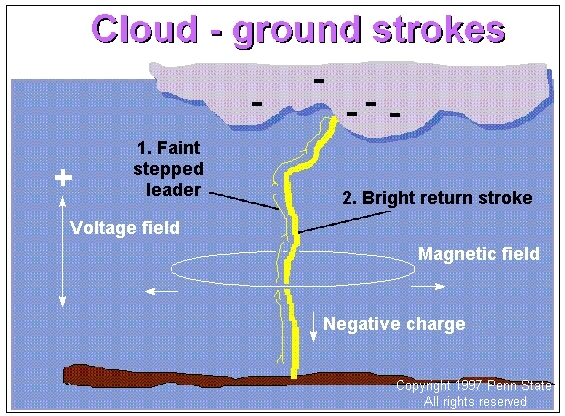




A better term for a lightning event is the flash that usually consists of a number of strokes. When the gradient between the cloud and the earth exceeds the breakdown threshold, the flash originates with a discharge or step of some 50 meters in length that emerges from the cloud and extends more or less toward the ground. In a few tens of microseconds, a second discharge extends from the lower end of the first step and, again, extends more or less toward the ground. This process is repeated in roughly 50-meter segments occurring at 20- to 50-microsecond intervals, lowers initial charge to ground, and is collectively termed the stepped leader. The stepped leader is too faint either to be seen by the eye or captured on film using ordinary photography. Because the currents of the leader steps are relatively small, they do not radiate large electromagnetic fields. When the descending stepped leader nears the ground, however, it raises the local potential gradient and initiates an upward propagating discharge. When the upward and descending discharges meet, a few tens of meters above the ground, the return stroke begins. This return stroke is a huge current that rapidly increases, in a few microseconds, to a peak of thousands of amperes as the stroke travels upward, at about half the speed of light, along the ionized pathway established by the stepped leader. It is this very large current that produces the brilliant display that we see and generates the large radiated electromagnetic field. From two to over 20 additional return strokes may occur every 50 milliseconds along the same ionized pathway, leading to the flickering appearance of the lightning flash lasting up to two seconds. Fortunately, from the direction-finding and locating viewpoint, the peak current occurs at the moment that the return stroke extends upward only a few hundred meters, when it is usually nearly vertical. From a distance, it thus appears as a vertically polarized radiator that is a point in a discrete direction. Further, such vertically polarized electromagnetic radiation is propagated primarily by surface waves that lack the bearing ambiguities that can accompany horizontally polarized radiation sources whose propagation is by both surface and sky waves.
The strength of the electric, E, and magnetic, B, components of the radiated field falls off as 1 / range if the earth's surface were a perfect conductor. Because the surface is less than perfect in this regard, attenuation with range is somewhat more rapid with a small exponential component. It is this nearly linear attenuation with distance that provides the basis for determining range by the GP-1. This determination would be a simple matter if all return strokes exhibited the same peak current. There is great variability, however, in the peak stroke-to-stroke, return current. This variability leads to a corresponding variability in the radiated power and, hence, in the received signal strength at a remote antenna. Thus, the field strength from a number of strokes in a given thunderstorm cell must be averaged to provide a usable value for range estimation. Fortunately a reasonably small number of return strokes yields a usable average or typical radiated field strength for use in range estimation.
The received strength of the magnetic component, B, of a typical stroke at a range of 100 km is about 2 x 10^-8 webers / square meter (see p. 113 of Uman's book). Because the weber is an awkwardly large unit for expressing lightning signal strengths, the practical weber' unit of 10^-8 webers is more convenient. With this practical unit then a typical returns stroke at 100 km range will produce a magnetic field, B', of 2 webers' / square meter.
The electric field, E, is related to the magnetic field, B, by the characteristic impedance of free space and its permeability m0 (Sears and Zemansky, pp. 520-521) as
